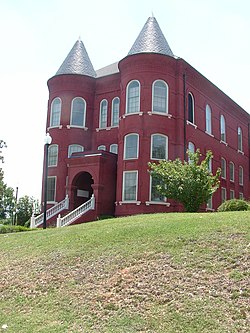East Raleigh–South Park Historic District
East Raleigh–South Park Historic District | |
 Leonard Hall at Shaw University | |
| Location | Roughly bounded by Bragg, East, E. Lenoir, Alston, Camden, Hargett, Swain, Davis, and S. Blount Sts., Raleigh, North Carolina |
|---|---|
| Coordinates | 35°46′20″N 78°38′00″W / 35.77222°N 78.63333°W |
| Area | 148 acres (60 ha) |
| Built | 1866 |
| Architect | Edward, Gaston A.; Et al. |
| Architectural style | Colonial Revival, Italianate |
| NRHP reference No. | 90001527[1] |
| Added to NRHP | October 11, 1990 |
The East Raleigh–South Park Historic District is the largest historically African-American neighborhood in Raleigh, North Carolina.[2] The district, located south and east of downtown Raleigh, covers approximately 30 blocks and contains portions of the Smith–Haywood and St. Petersburg neighborhoods. Most homes in these neighborhoods were built between 1900 and 1940, with one-fifth dating back to the 19th century.[3] Historic buildings in the district include Estey Hall and Leonard Hall, both located on the campus of Shaw University. The district was listed on the National Register of Historic Places in October 1990.
During the 1980's and 1990's portions of the district were redeveloped by the City of Raleigh housing authority in a slum clearance exercise in an effort to redevelop the neighborhood and improve infrastructure. [4]
See also[edit]
References[edit]
- ^ "National Register Information System". National Register of Historic Places. National Park Service. July 9, 2010.
- ^ Lewis, Ericka (February 14, 2000). "Tourism Brochure Maps African-American Sites in NC". wral.com. Retrieved March 25, 2008.
- ^ "Neighborhood Descriptions". godowntownraleigh.com. Archived from the original on May 13, 2008. Retrieved March 25, 2008.
- ^ "South Park Redevelopment Plan" (PDF). Retrieved October 10, 2023.
External links[edit]
 Media related to East Raleigh–South Park Historic District at Wikimedia Commons
Media related to East Raleigh–South Park Historic District at Wikimedia Commons- National Register Historic Districts in Raleigh, North Carolina, RHDC
- East Raleigh-South Park Historic District, RHDC
- Historic districts on the National Register of Historic Places in North Carolina
- National Register of Historic Places in Raleigh, North Carolina
- Italianate architecture in North Carolina
- Colonial Revival architecture in North Carolina
- African-American history in Raleigh, North Carolina
- Neighborhoods in Raleigh, North Carolina
- Raleigh, North Carolina Registered Historic Place stubs




